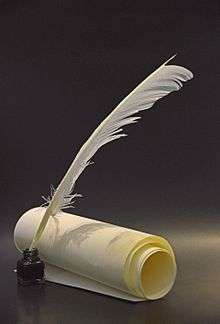Klaf
Klaf or Qelaf (Hebrew: קָלַף) is the designation given a particular piece of skin. The Talmudic definition includes both the form of the skin and the way it is processed, in particular that it must be tanned. Since the innovative ruling of Rabbeinu Tam (12th century Tosafist) it is primarily used to refer to parchment or vellum. It is one of the materials upon which a Sofer writes certain Jewish liturgical and ritual documents.

Description
Klaf is a specially prepared tanned, split skin of a kosher animal - goat, cattle, or deer. Rabbinic literature addresses three forms of tanned skin: Gevil, consisting of the full, unsplit hide; and klaf and dukhsustus which are the two halves of the full hide. Rabbinic literature is divided upon which is the inner and which is the outer of the two halves.
According to the Halakhot Gedolot, klaf is the inner layer, adjacent to the flesh, while dukhsustos is the outer layer, on which the hair grows:
- תניא הלכה למשה מסיני תפילין על הקלף ומזוזה על דוכסוסטוס וקלף במקום בשר ודוכסוסטוס במקום שער.
- A baraita states: It is a Law given to Moses at Sinai that tefilin are written on qelaf and mezuzah on dukhsustus. Qelaf [is written] where it [faced] flesh; dukhsustus, facing hair. — (Hilkhot Tefilin, perek 25 daf 100 in Venice 1548 printing)
The same view is expressed in the oldest extant manuscripts and critical editions of Maimonides' Mishneh Torah and the Babylonian Talmud (Shab. 79b). This is also the same definition which appears in the minor Talmudic tractate called Sofrim. However, more recent authorities reverse the two descriptions, and many printed editions of the Mishneh Torah are "adjusted" to reflect this. The reason for this reversal of terms is a mystery. Some suspect that copying errors are to blame. As a result, many have become confused, in terms of which part of the skin should be used for writing. Using the full hide known as gevil for Sifrei Torah does avoid this issue, but unfortunately this solution won't work for tefilin which must be written on Klaf and are not kosher if written on gevil.
This dispute may be of very little practical significance as the main schools of thought today on each side are in agreement over the identity of the klaf, with the only dispute being whether Duchsustus is the skin layer on the outside or the membrane on the inside, with writing on duchsustus having fallen out of all common practice centuries ago.
However, there is a small group which breaks with the tradition and understands that the Klaf is the thin outer layer with the Duchsustus being the thicker, inner layer.) In any event in agreement is that klaf can only be written upon on its own inner layer and Duchsustus on its own outer layer. For each of sifrei torah, tefilin, and mezuzos there are different guidelines and restrictions of which form of the skin may be used i.e. tefilin can only be made from klaf.
Preparation
The legally required method of cleaning and preparing klaf has been altered over the centuries. During Talmudic times, salt-water and barley (or flours) were sprinkled on the skins which were then soaked in the juice of afatsim (gall nuts, or Oak apples). Nowadays, most processors dip the skins in clear water for two days, and then soak them in limewater for nine days to remove the hair. When it is a hairless surface, the scribe stretches it on a wooden drying frame and scrapes it until it is dry. Creases are ironed out with presses. Then it is sanded until it becomes a flat, smooth sheet fit for writing. The reasons for the change in this process are lengthy and controversial. Today, a few Jewish scribes still prepare klaf in precise accordance with the Jewish Law.
Some parchment (usually poor quality) is smeared with log, a chalky substance, to make it whiter. Occasionally this is only done on the reverse. Some scribes object to the use of log as it forms a barrier between the ink and the parchment.
Uses
In Talmudic times klaf was primarily only used for tefilin and at times mezuzos however since the 9th or 10th centuries it has become more widespread to write Sifrei Torah on klaf however, even today, there are still groups who continue to adhere to the ancient prescription described in the Talmud, and continue to write on gevil.
Intent
The parchment must be prepared "for the sake of heaven" (i.e. with the intent of performing a Divine act) and the processor must declare what he is preparing it for, as one cannot use k'laf destined for a lesser holiness (kedusha kallah) - e.g. a mezuzah to write tefillin or a Sefer Torah, which are of weightier holiness (kedusha chamurah). If necessary, the scribe should state that he is preparing for the sake of a Sefer Torah but that he may change his mind if he wishes. Some believe that when a Jew is unable to prepare the parchment, then in exceptional circumstances, a non-Jew may prepare it. However, a Jew must stand over him, directing him in his work and stating that the preparation is for the sake of heaven. However, this issue is not universally accepted.
Current production
Today there is a large amount of Klaf processed under rabbinical supervision, and the variety, quality and quantity is increasing.
